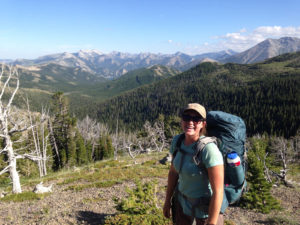 Starry night skies, the satisfaction of settling into a cozy sleeping bag after a long day of hiking, the soothing sound of a nearby stream; these are a few of the things that make sleeping outside so enjoyable. After two months of sleeping in the backcountry and quiet camp sites, I have grown accustomed to falling asleep to the sound of running water. Following a six day backpack in Waterton Lakes Nation Park, my WRFI group had the privilege of staying with our guest speakers, Rob and Loretta Schaufele. Access to indoor plumbing, a delicious meal, and s’mores around a bonfire made camping in their backyard a special treat. Their outstanding generosity and hospitality reinforced the stereotype that “all Canadians are really nice.”
Starry night skies, the satisfaction of settling into a cozy sleeping bag after a long day of hiking, the soothing sound of a nearby stream; these are a few of the things that make sleeping outside so enjoyable. After two months of sleeping in the backcountry and quiet camp sites, I have grown accustomed to falling asleep to the sound of running water. Following a six day backpack in Waterton Lakes Nation Park, my WRFI group had the privilege of staying with our guest speakers, Rob and Loretta Schaufele. Access to indoor plumbing, a delicious meal, and s’mores around a bonfire made camping in their backyard a special treat. Their outstanding generosity and hospitality reinforced the stereotype that “all Canadians are really nice.”
However, rather than the sound of a trickling creek, the background noise throughout the evening was the rush of traffic on Highway 3, a busy road just behind the Schaufele’s home in Western Alberta. While this couple has become accustomed to the din of cars and RVs zooming by, I was surprised by the noise. Yet this highway creates more than just an annoying sound—it acts as a death zone to crossing wildlife and a major source of habitat fragmentation in the region.
After over a decade of living along Highway 3, the Schaufeles may not mind the noise, but they do dislike seeing the frequent and bloody roadkill along the highway. Most people, including myself, often see dead deer and other wildlife along roads, briefly mourn the “poor animal” and zoom past without a second thought. The Schaufeles, on the other hand, look at road kill as a source of inspiration and take the time in their busy lives to address this issue. Rob is the director of “Roadwatch in the Pass”, a ground-breaking program created by the Miistakas Institute (of the University of Calgary) to collect roadkill data along the Crowsnest Pass region of Highway 3. Their aim is to gain more knowledge about how many animals die each year due to vehicle collisions and record observations of wildlife movement.
Over the past several years, the program has been collecting data through citizen science. Citizen science implements local knowledge and allows research to be augmented by the participation and insight of everyday people. While this may not be an effective method for all types of research, it has worked well for the Roadwatch program. Part of the program involves a set of volunteers that hike along the highway in search of roadkill that escaped the roadsides. We got to experience this as Rob and Loretta took us on a walk through fields of grass and mud near the highway in search of bones and bodies. While it may sound morbid, the work is fascinating. During the walk, Rob proudly pulled out his smartphone to show us the program’s new app, which allows volunteers to record the duration of their hike, identify where they find signs of roadkill using GPS coordinates, and to submit a picture of the find. All this information is sent to a database that synthesizes it. A plethora of useful data has been collected. Now, that information is being used to determine the best place to construct underpasses or overpasses that would help animals cross the road safely. Though it takes time for animals to learn to use these bridges, they have been successful in protecting both animals and people from collisions. These structures have been effective in nearby areas, such as Banff National Park, where we drove on top of underpasses in route to another backpacking trip.
The Crowsnest area, Banff, and other regions of Alberta make up a small part of the much larger Yellowstone to Yukon bioregion. Connectivity is an essential part of efforts to conserve this area, and roads act as a major source of fragmentation. Not only are roads a direct source of wildlife fatality, fragmentation also causes in-breeeding depression, local extinction, and many other problems. It’s easy to get discouraged when faced with the challenge of conserving such a large and complex area, but the Schaufele’s efforts in their community and other local initiatives give me hope. As Barry Lopez writes, these people are “local geniuses” and their “intimate” knowledge of the land “rings with the concrete details of experience.” Success, I’ve learned, comes from the combined efforts of people who truly care about their homes.